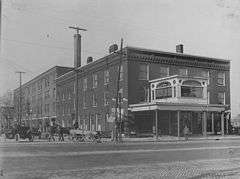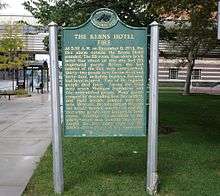Kerns Hotel fire
The Kerns Hotel fire of December 11, 1934 in Lansing, Michigan, United States, killed 34 people, including seven Michigan state legislators, and according to the Lansing Fire Department, was the worst fire disaster in the history of Lansing. The fire occurred around 5:30 am and spread rapidly through the building's wooden interior, trapping many of the hotel's 215 guests in their rooms and forcing them to escape via fire ladders or life nets. In addition to the fatalities, 42 more people, including fourteen firemen, were injured in the fire, which was thought to have been caused by a carelessly discarded cigarette.[1][2]
 Kerns Hotel in its early days, shown at left in the background. The three-story Hotel Wentworth shown in the foreground survived the fire. | |
| Date | December 11, 1934 |
|---|---|
| Location | Lansing, Michigan |
| Coordinates | 42°44′04″N 84°33′01″W |
| Type | Fire |
| Cause | Carelessly discarded cigarette |
| Deaths | 34 |
| Non-fatal injuries |
|
History of the Kerns Hotel
The Kerns Hotel was located in the 100 block of N. Grand Ave. in Lansing, Michigan. It was built in 1909 by William G. Kerns as a four-story, 162-room hotel, constructed of brick with a wooden interior. The hotel cost $50,000 to build and was the first hotel in the state of Michigan to have running ice water in all of its rooms. By 1934, the total number of rooms had been increased to 211. State legislators and community groups often stayed at the hotel because of its location and amenities, including a popular bar and restaurant.[1][2]
Fire

On December 11, 1934, a fire broke out in the Kerns Hotel killing 32 people and injuring 44, including 14 firemen. The alarm bell sounded at 5:30 am in the 211-room four-story brick hotel. Many guests escaped by utilizing one of the four fire ladders or utilized the life nets, but due to the wooden interior many guests were trapped in their rooms.[3] Two of the injured people died later, bringing the death toll to 34.
Victims
Among the dead were seven Michigan state legislators, state senator John Leidlein and state representatives T. Henry Howlett, Charles D. Parker, Vern Voorhees, John W. Goodwine, Don E. Sias, and D. Knox Hanna, who were in town for a special session of the Michigan legislature.[4][1] A number of other legislators were injured but survived, including Maurice E. Post, Charles T. Kimball, and John Dykstra.[5][6] Many of the hotel's 215 guests at the time escaped by the four fire ladders provided by the fire services, and eight people leapt out of the hotel onto nets.[1]
Aftermath
Firefighters and evacuated guests were aided by the Lansing and Michigan State Police, the Red Cross, the Salvation Army, the Volunteers of America and private citizens with clothing and food, as well as monetary support. There are two historical markers in Michigan dedicated to the event and the responders.[3]
The fire was widely covered by media, including appearing as the front page lead story in The New York Times and in the Illustrated London News. A memorial song, "The Lansing Hotel Fire", was written and published in 1935 by Walter Coon of Royal Oak, Michigan.
References
- "Box 23". Lansing Fire Department. Archived from the original on 2013-07-27. Retrieved 2016-01-08.
- "The Hotel Kerns Fire". cadl.org. Capital Area District Library. Archived from the original on 2013-04-03. Retrieved 2016-01-08.
- Ashlee, Laura Rose (2005). Traveling Through Time: A Guide to Michigan's Historical Markers. Michigan: University of Michigan Regional. p. 167. ISBN 978-0472030668.
- "National Affairs: Legislators at Lansing". Time. Time.com. 1934-12-24. Retrieved 2016-01-08.
- Beitler, Stu, ed. (2007-11-02). "Lansing, MI Hotel Kerns Fire Disaster, Dec 1934 (page 1)". Gendisasters.com. Retrieved 2016-01-08.
- Beitler, Stu, ed. (2007-11-02). "Lansing, MI Hotel Kerns Fire Disaster, Dec 1934 (page 2)". Gendisasters.com. Archived from the original on 2015-01-10. Retrieved 2016-01-08.